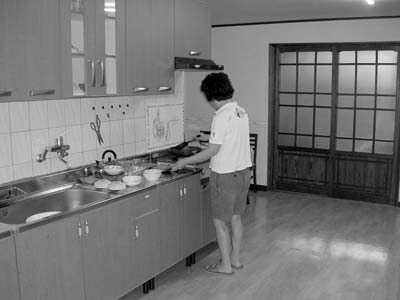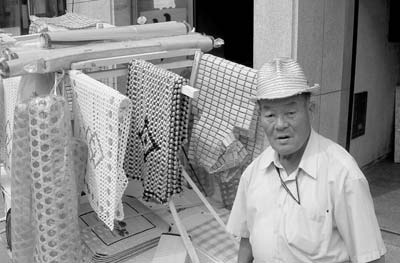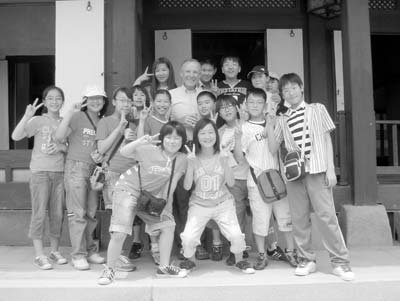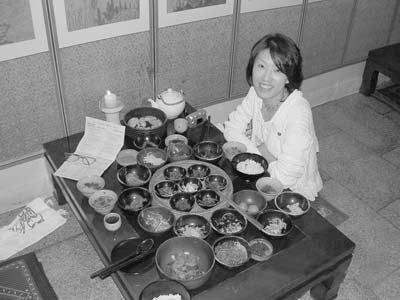Solo travel in South Korea
South Korea, the Land of the Morning Calm, is anything but calm. It’s a totally dynamic, 24/7 country. Alone on a week-long business trip to Daegu in June ’06, I extended my stay, adding a week in Seoul to experience South Korea. I avoided the common tourist spots.
My goal for this, my first trip to this country, was participation, not observation. The first step was locating accommodations and getting maps. Two calls to the Korean National Tourism Office (Fort Lee, NJ; 800/868-7567, www.tour2korea.com) each elicited courteous promises of maps and booklets, but none of the promised materials came, so I turned to the Internet. There was a wealth of travel information, none very specific or detailed. I found most to have been prepared for the 2002 World Cup and significantly dated.
Lonely Planet (the latest edition was published in 2004) was full of touring information but had limited specifics on yogwans, the small Korean hotels equivalent to the Japanese minshuku, which I prefer. Taking a chance, I decided on a homestay in Daegu and contacted Pine Homestay (see my note at the end). After reviewing my references, Pine, the nickname of Kyeong-Seon Kwak, agreed to welcome me into her home for a fee of $30 a night including Korean breakfast.
For my stay in Seoul I selected Hotel Jongnowon (29, Iksundong, Jongno-gu, Seoul, Korea; phone 82 2 763 4249 or 82 2 745 6876 or visit www.jongnowon.com) for its location and its rooms with refrigerator, A/C, toilet and shower, plus Internet, all at only 28,000 won (about $30) including breakfast. I used the hotel’s Internet site to request my reservation and received no reply — a cause of worry as my departure date approached; a call by a Korean-speaking friend reassured me.
The Internet provided the path to meeting my goal of participating in Korea. On the Korean tourism office’s website I found a link to the Goodwill Guides and applied for a guide for my week in Seoul. I got two! I had no idea what a spectacular gift they were to be.
In addition, I did a search about my hobby, marathon racing, on Google. There I located a running club, Seoul Synergy, and e-mailed them. That yielded a Korean friend and two half-marathon race entries.
This was my first experience with the wonderfully welcoming and generous Koreans. Travelers who don’t participate in their hobby, be it running, gardening, bridge, cooking, photography or dance — anything — are missing the chance of a lifetime to break out of the tourist shell, make friends and have personal experiences.
Flying Singapore Air (800/742-3333, www.singaporeair.com/usa) for the first time, I looked forward to a step up from the usual coach cattle car. Sadly, it was not to be.
Singapore Airlines did meet the basic requirements of a safe flight, departing and arriving on time both ways. The airline’s much-touted entertainment system, however, offered a vast number of movies on a screen so small, I seriously needed stronger reading glasses. Figuring out how to select movies, videos or music from the well-over 100 choices was complex enough to entertain this engineer for over an hour. And the flight did not measure up to my best transpacific coach flights on Korean Air to Tokyo.
Inclusive of taxes and fees, my fare through www.orbitz.com was $935 round trip from Santa Barbara, California. One of the fees was a $35 paper-ticket fee; Orbitz cannot issue e-tickets on a United/Singapore Airlines itinerary.
Contacting Singapore Airlines directly by phone, as I always do, to confirm online or consolidator reservations and make meal selections, I discovered that Orbitz (a division of Travelport, a large travel distributor/wholesaler) is now just like all other travel agents or online ticket sellers and no longer is the airline’s official site. Any ticket changes, which I luckily did not need, would have to be made through my “travel agent,” Orbitz. I would have received better service and an e-ticket, lowering the price a bit, had I booked directly.
Arriving in Inchon, I found a beautiful and efficient new international airport serving Seoul. An ATM provided sufficient won for my week in Daegu. There were few airport ATMs, and later, in Seoul, the only international ATMs I could locate were in large department stores or international banks; the several Korean banks I checked did not have them.
A 4-hour bus trip delivered me to Daegu very late in the night and to my first meeting with Pine. As instructed, I had the taxi driver call her for directions and I was soon rocketing through the dark streets of Daegu. Pine was waiting in the street with a warm welcome and led the taxi up a steep narrow lane to a modest 3-story apartment building.
Paying the taxi driver 6,000 won ($6.50), I was then led by Pine not up but down the stairs to her basement apartment. I was in a Korea very rarely visited by outsiders: the basic home of a middle-class Korean. Pine’s English was limited but good enough to get along well without hand signs.
I was shown my room, one of two; Pine slept in the other. My room was about nine by nine feet, furnished with a hard couch, low shelves and a thin sleeping mat in the middle of the floor in the traditional Korean fashion. The pillow was small and hard, full of what I later learned were barley hulls. There was a TV with English channels and a telephone. The toilet and tub, with hand shower, were Western, but the towel was the small Asian type. After 20 hours of travel I slept well, despite being in the most foreign of worlds.
My first morning’s breakfast, and my introduction to basic Korean food, was transparent noodles with beef, rice with black beans, cucumber salad and tea. The other five were nearly identical. This is typical, as Koreans eat similar food for breakfast, lunch and dinner.
Pine was a most accommodating hostess. On my first day she took me, by bus, as few Koreans have cars, to my work location and to the train station to purchase a ticket. Pine was waiting and worrying each night as I returned “home” at about 9. I had a Korean mother!
Daegu, where my work was located, is a business city of about one million and does not offer a great deal for the tourist. I ran the Buddha Half-Marathon in the hills south of Gyeongju. On arrival at the race, I was immediately adopted by English-speaking runners and had a wonderful and challenging run. As the only foreigner, likely the oldest runner and thankfully not the last finisher, I was congratulated at the finish by the race director and photographed in the finish lane with a friendly Buddhist monk.
The train KTX, at 300kph (186 mph), was both faster and smoother than Japan’s famed bullet trains and got me to Seoul in just 1½ hours after my work in Daegu was complete. In the countryside, in the middle of nowhere, I was amazed to see numerous “New Towns,” groups of five to twenty 15-story apartment buildings. Everywhere I looked was a faster, newer or bigger Korea — new trains, roads and buildings, even parks. Korea is building an entirely new country.
Seoul is an easy-to-manage very big city. My first stop was the subway ticket window to buy my “T money” card (2,500 won, or $2.60), my prepaid subway ticket. Most trips are 900 won ($1), as was mine to Anguk Station near my hotel, so the 5,000 won I put on it was good for several days. Now the fun began.
Making my way to Hotel Jongnowon, I missed a turn and was totally lost. As if I needed to be told, the short man pulling a huge cart of wicker repeated, “Lost?,” in the gruff voice of a drill sergeant. “Yes,” I replied. He grabbed my directions, then, taking my arm, said, “This way,” leaving his cart as it stood and heading up a small street. In moments I was delivered to Hotel Jongnowon and he was gone. Saved by another of many friendly and helpful Koreans!
Hotel Jongnowon had just a dozen rooms but was clean and comfortable for a no-star hotel. I ate excellent dinners in the small restaurants around the hotel. Rarely did they cost over 6,000 won ($6), and there was no tax or tip, which was a pleasant surprise. The big department stores all had wonderful food halls on the lowest floor, with lots of free samples, providing lunch adventures and food for breakfasts.
My days were full of Korea but no museums. I attended the morning worship at Jogyesa Temple. Then I was a beneficiary of the free lunch offered by Jogyesa and most Buddhist temples. Expecting to pay, I just joined the long line of mostly well-dressed people entering the basketball-court-size dining hall. We were never even asked to donate, though there was a donation box. Lunch was a huge plate of basic vegetarian fare, built around rice and kimchi. I joined the throngs at a table for 24 and cleaned my plate, as required by the Buddhist prohibition against waste. I was stuffed!
I then walked to the nearby Gyeongbokgung Palace, which was much like a half-size “Forbidden City” and free, like most palaces and museums, if you are over 65, as I am. There the highlight was meeting two school classes, a hyper bunch of sixth graders from Buson and a very sweet and gentle group of eighth graders from the National School for the Blind. Both teachers approached me out of the blue and asked if I wanted to meet their students. What an honor!
The highlight of Korea was my two Goodwill Guides. I had communicated with both by e-mail before arrival and our meetings were carefully set. Young-bin and Kijo were the most charming of young women. Young-bin and I went to Sanchen, a very famous Buddhist-style restaurant, for a lunch I could not have ordered or enjoyed without her help.
She then took me to a traditional dance festival put on by a school for young dancers. The kids and their parents were wonderful. Kijo and I went to the Noryangjin Fish Market, bought three small live fish, had them cut into sashimi, took them to a nearby restaurant and lunched on our raw fish and soup made from their bones and heads. We then went to the Dongdaemun Market with its thousands of shops — an unbelievable orgy of 24/7 shopping.
Not only did I have wonderful experiences but, much more important, I now have two new and very special Korean friends.
This trip was not soft adventure but cultural hard adventure, harder than running a marathon and very rewarding. All of my meals were Korean, and I slept on the floor half the nights.
I recommend South Korea strongly! Sadly, I saw very few Westerners. There is more, much more. I welcome your questions and the chance to go into specifics about staying at the Pine Homestay. (I intentionally omitted Pine’s e-mail address as her homestay is not for everyone.) Contact me c/o ITN.
ED GRAPER
Goleta, CA




